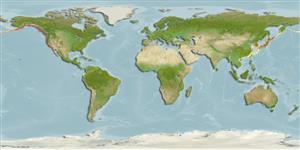Acmaea mitra Eschscholtz, 1833
Dunce cap limpet| Native range | All suitable habitat | Point map | Year 2050 |

|
| This map was computer-generated and has not yet been reviewed. |
| Acmaea mitra AquaMaps Data sources: GBIF OBIS |
Upload your photos
Google image |
No photo available for this species.No drawings available for Acmaeidae.
Google image |
No photo available for this species.
Classification / Names Common names | Synonyms | CoL | ITIS | WoRMS
Gastropoda | Patellogastropoda | Acmaeidae
Environment: milieu / climate zone / depth range / distribution range Ecology
Benthopelagic; depth range 0 - 30 m (Ref. 865). Subtropical
Distribution Countries | FAO areas | Ecosystems | Occurrences | Introductions
Pacific Ocean: Bering Sea, Alaska, Canada, USA, Mexico. Boreal to subtropical.
Length at first maturity / Size / Weight / Age
Maturity: Lm ? range ? - ? cm Max length : 3.5 cm TL male/unsexed; (Ref. 865); common length : 3.5 cm TL male/unsexed; (Ref. 312)
Northeast Pacific; Eastern Central Pacific: from the Bering Sea to Mexico. 3.5 cm long, shell size. Description: Shell has a high pointed cone shape, entirely white and smooth, often covered with pink coralline algae (Ref. 312). Occurs in low intertidal zones (Ref. 312). Also in shallow subtidal areas, on rocks with encrusting coralline algae (Ref. 95344). Herbivorous, prefers red and pink coralline algae (Ref. 312).
Life cycle and mating behavior Maturity | Reproduction | Spawning | Eggs | Fecundity | Larvae
Members of the order Patellogastropoda are mostly gonochoric and broadcast spawners. Life cycle: Embryos develop into planktonic trocophore larvae and later into juvenile veligers before becoming fully grown adults.
Main reference
References | Coordinator | Collaborators
Gallivan, G. and J. Danforth. 1999. (Ref. 312)
IUCN Red List Status (Ref. 130435)
CITES status (Ref. 108899)
Not Evaluated
CMS (Ref. 116361)
Not Evaluated
Threat to humans
Human uses
| FishSource |
Tools
More information
Age/Size
Growth
Length-weight
Length-length
Morphology
Larvae
Abundance
Growth
Length-weight
Length-length
Morphology
Larvae
Abundance
Internet sources
BHL | BOLD Systems | CISTI | DiscoverLife | FAO(Publication : search) | Fishipedia | GenBank (genome, nucleotide) | GloBI | Gomexsi | Google Books | Google Scholar | Google | PubMed | Tree of Life | Wikipedia (Go, Search) | Zoological Record
Estimates based on models
Preferred temperature
(Ref. 115969): 6.4 - 17.5, mean 10.1 (based on 499 cells).
Price category
(Ref. 80766):
Unknown.


